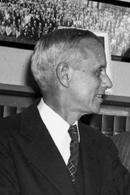Edmund Ware Sinnott

Edmund Ware Sinnott (February 5, 1888 in Cambridge, Massachusetts – January 6, 1968 in New Haven, Connecticut) was an American botanist and prolific textbook author. He is best known for his work in plant morphology.
Life
Sinnott received his A.B. in 1908, his M.A. in 1910, and his Ph.D. in 1913 all from Harvard. He had studied in Australia with Arthur J. Eames from 1910-1911. Upon graduation, he became an instructor at Harvard, and worked with I. W. Bailey, the anatomist. From 1915-1928, he was at the Connecticut Agricultural College at Storrs, becoming Professor of Botany and Genetics. From 1928-1939, he was Professor of Botany at Barnard College and chair of the Botany Department at Columbia University (1939-1940). In 1940, he moved to Yale University to become Sterling Professor of Botany, chair of the Botany Department (1940-1956), director of the Marsh Botanical Garden (1940-1950), dean of the Graduate School (1950-1956) and director of Sheffield Scientific School (1945-1956).
He was also made editor of the American Journal of Botany, member of the National Academy of Sciences, and president of the Botanical Society of America, the American Society of Naturalists and the American Association for the Advancement of Science.
He was the co-author of the textbook Principles of Genetics (1925) which received positive reviews.[1][2][3][4]
Throughout his life, Sinnott was a prolific author; he wrote ninety scientific articles and many textbooks. Sinnott contributed to the field of Colonial and early American Architecture with his book Meetinghouse & Church in Early New England (1963), with photographs by Jerauld Manter.
In his teaching, Sinnott stressed the idea of scientific discovery and the importance of making careful measurements and correctly interpreting data. He endeavored to explain the organism as an integrated whole from the sum of its parts, processes and history.
He retired in 1956 and died in New Haven in 1968.
Philosophy
Sinnott was a proponent of organicism and a critic of reductionism.[5][6] He held that view that life is goal directed and purposive.[7][8]
In his book Biology of Spirit (1955) he used the term Telism which he defined as "the philosophy of goals-a belief that what is important is not the push and drive of a living system but the drawing power of a goal, conscious or unconscious, that in some is established in it". His philosophy was compared by critics to a form of vitalism.[9][10] Others such as George Gaylord Simpson claimed Sinnott was promoting a theological version of orthogenesis.[11][12]
He rejected both dualism and materialistic monism for his own philosophy which was described by a reviewer as idealistic monism. He argued for the existence of an impersonal God which he described as a purposive organizing agent.[13][14] He was criticized by Leo Koch for making metaphysical statements in his science books, he stated for example "The Principle of Organization is far more than a scientific concept. It states a belief that there is operating in the universe a something that leads to spirit; something that is spirit."[9]
In his book Cell and Psyche (1950) he argued that mind and matter are two aspects of the same phenomenon and that purpose exists in all organisms as it is built into the genotype and the protoplasm.[15]
Publications
- Botany, Principles and Problems (1923, sixth edition in 1963)
- Principles of Genetics (1925, third edition in 1934)
- Laboratory Manual for Elementary Botany (1927)
- Cell and Psyche (1950)
- Two Roads to Truth (1953)
- The Biology of the Spirit (1955)
- Life and Mind (1956)
- Matter, Mind, and Man (1957)
- Plant Morphogenesis (1960)
- The Bridge of Life: From Matter to Spirit (1966)
References
- ↑ Caspari, Ernst. (1950). Principles of Genetics by Edmund W. Sinnott, L. C. Dunn, Th. Dobzhansky. Science . New Series, Vol. 112, No. 2920. p. 725.
- ↑ Colin, Edward C. (1952). Principles of Genetics by Edmund W. Sinnott, L. C. Dunn, Th. Dobzhansky. The American Biology Teacher. Vol. 14, No. 4. p. 101.
- ↑ Fogel, S; Herskowitz, I. H. (1952). Principles of Genetics by Edmund W. Sinnott, L. C. Dunn, Th. Dobzhansky. The Quarterly Review of Biology. Vol. 27, No. 2. pp. 210-211.
- ↑ Sobels, F. H. (1959). Principles of Genetics by Edmund Sinnott, L. C. Dunn, Theodosius Dobzhansky. The Quarterly Review of Biology. Vol. 34, No. 2. p. 151.
- ↑ Miller, David L. (1958). Sinnott's Philosophy of Purpose. The Review of Metaphysics. Vol. 11, No. 4. pp. 637-647.
- ↑ Stiernotte, Alfred P. (1959). Sinnott's Philosophy of Organism. The Review of Metaphysics. Vol. 12, No. 4, pp. 654-661.
- ↑ Oppenheimer, Jane. (1956). Biology of the Spirit by Edmund W. Sinnott. American Scientist. Vol. 44, No. 1. p. 70.
- ↑ Sachs, Roy M. (1968). The Bridge of Life: From Matter to Spirit by Edmund W. Sinnott. The Quarterly Review of Biology. Vol. 43, No. 2. pp. 185-186.
- 1 2 Koch, Leo Francis. (1957). Vitalistic-Mechanistic Controversy. The Scientific Monthly. Vol. 85, No. 5. pp. 245-255.
- ↑ Dobzhansky, Theodosius; Hecht, Max K; Steere, William C. (1968). Evolutionary Biology, Volume 2. Plenum Press. pp. 4-5. ISBN 978-1-4684-8096-2
- ↑ Simpson, George Gaylord. (1964). Evolutionary Theology: The New Mysticism. In This View of Life: The World of an Evolutionist. Harcourt, Brace & World. pp. 213-233
- ↑ Beatty, John. (2008). Chance Variation and Evolutionary Contingency: Darwin, Simpson, The Simpsons, and Gould. In Michael Ruse. The Oxford Handbook of Philosophy of Biology. Oxford University Press. p. 196. ISBN 978-0-19-518205-7
- ↑ McCrady, Edward. (1956). The Biology of the Spirit by Edmund W. Sinnott. The Sewanee Review. Vol. 64, No. 1. pp. 136-144.
- ↑ Swanson, C. P. (1956). The Biology of the Spirit by Edmund W. Sinnott. The Quarterly Review of Biology. Vol. 31, No. 2. p. 120.
- ↑ Glass, Bentley. (1952). Cell and Psyche: The Biology of Purpose by Edmund W. Sinnott. The Quarterly Review of Biology. Vol. 27, No. 1. p. 62.
- ↑ IPNI. Sinnott.